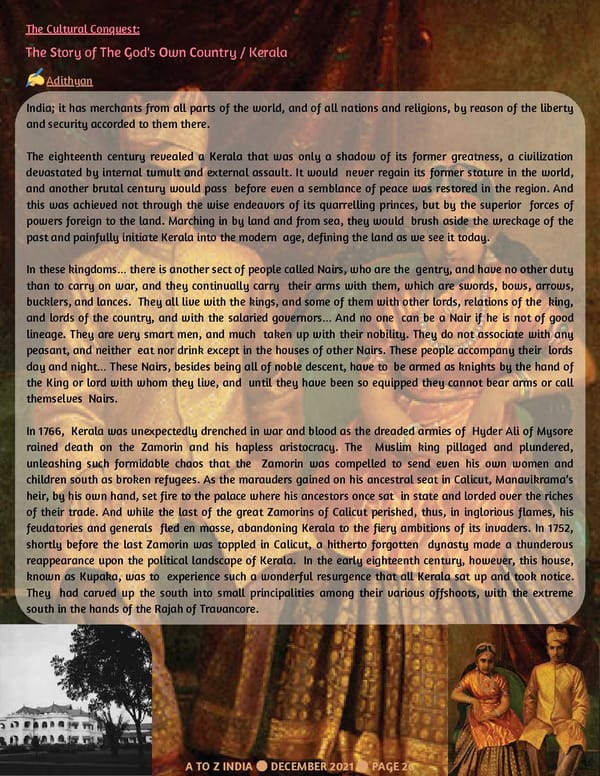India; it has merchants from all parts of the world, and of all nations and religions, by reason of the liberty and security accorded to them there. The eighteenth century revealed a Kerala that was only a shadow of its former greatness, a civilization devastated by internal tumult and external assault. It would never regain its former stature in the world, and another brutal century would pass befo re even a semblance of peace was restored in the region. And this was achieved not through the wise endeavors of its quarrelling princes, but by the superior forces of powers foreign to the land. Marching in by land and from sea, they would brush aside the wreckage of the past and painfully initiate Kerala into the modern age, defining the land as we see it today. In these kingdoms ... there is anoth er sect of people called Nairs, who are the gentry, and have no other duty than to carry on war, and they continually carry their arms with them, which are swords, bows, arrows, bucklers, and lances. They all live with the kings, and some of them with other lords, relations of the king, and lords of the country, and with the salaried governors ... And no one can be a Nair if he is not of good lineag e. They are very smart men, and much taken up with their nobility. They do not associate with any peasant, and neither eat nor drink except in the houses of other Nairs. These people accompany their lords day and night ... These Nairs, besides being all of noble descent, have to be armed as knights by the hand of the King or lord with whom they live, and until they have been so equipped they cannot bear arms or call themselves Nairs. In 1766, Kerala was unexpectedly drenched in war and blood as the dreaded armies of Hyder Ali of Mysore rained death on the Zamorin and his hapless aristocracy. The Muslim king pillaged and plundered, unleashing such formidable chaos that the Zamorin was compelled to send even his own women and children south as broken refugees. As the marauders gained on his an cestral seat in Calicut, Manavikrama’s heir, by his own hand, set fire to the palace where his ancestors once sat in state and lorded over the riches of their trade. And while the last of the great Zamorins of Calicut perished, thus, in inglorious flames, his feudatories and generals fled en masse, abandoning Kerala to the fiery ambitions of its invaders. In 1752, shortly before the last Zamorin was toppled in Calicut, a hitherto forgotten dynasty made a thunderous reappearance upon the political landscape of Kerala. In the early eighteenth century, however, this house, known as Kupaka, was to experience such a wonderful resurgence that all Kerala sat up and took notice. They had carved up the south into small principalities among their various offshoots, with the extreme south in the hands of the Rajah of Travancore. A TO Z INDIA ● DECEMBER 2021 ● PAGE 26 Adithyan The Story of The God's Own Country / Kerala The Cultural Conquest:
 A TO Z INDIA - DECEMBER 2022 Page 25 Page 27
A TO Z INDIA - DECEMBER 2022 Page 25 Page 27